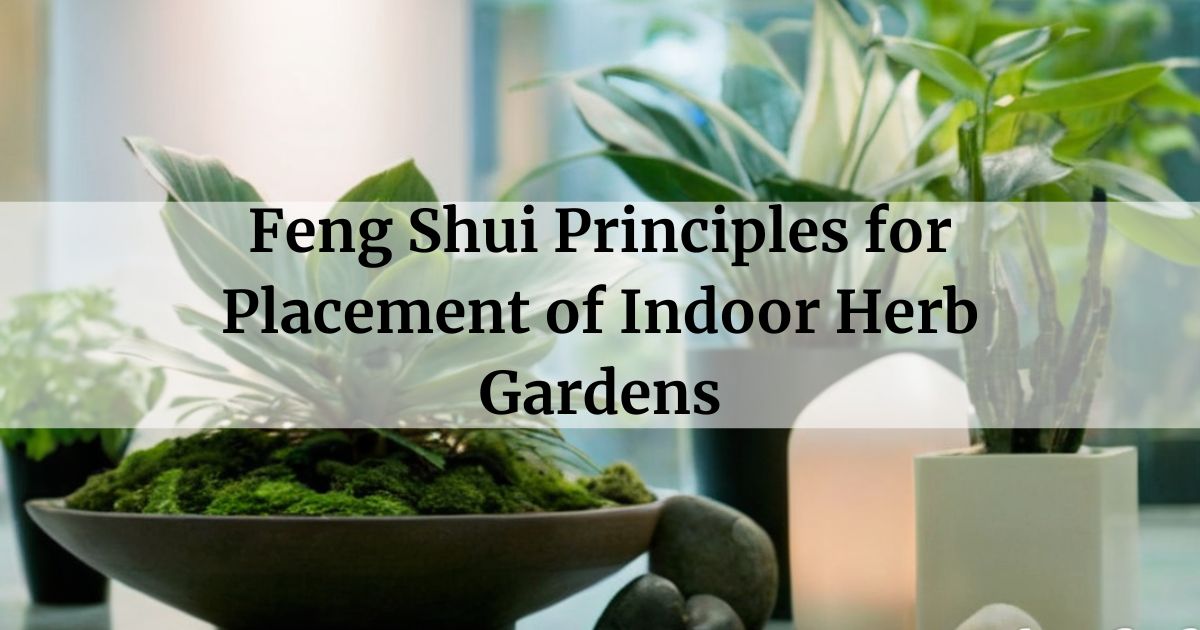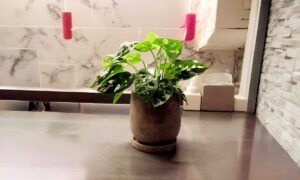
Wondering where to position your indoor herb garden for optimal growth? Feng shui, the ancient Chinese practice of placement and arrangement, can offer helpful guidance.
In this article
Key takeways
To optimize the Feng Shui energy in your indoor herb garden, follow these practical tips:
| Tips for Feng Shui Indoor Herb Gardens |
|---|
| 1. Choose the Right Plants: Select herbs that not only thrive indoors but also align with your intentions for the space. |
| 2. Create Zones: Divide your garden into different zones based on the elements or plant types to maintain balance. |
| 3. Use Natural Materials: Opt for natural materials like clay pots or wooden planters to enhance the earth element in your garden. |
| 4. Maintain Cleanliness: Regularly prune and care for your herbs to promote a sense of calm and well-being in your space. |
The key feng shui principle for indoor herb gardens is chi, or vital energy. Chi flows smoothly through a space when clutter is minimized and obstacles removed. Your herbs will thrive with positive chi circulation.
As the owner of a small indoor herb garden, I’ve found optimal placement is near a window catching both light and warmth. South-facing windows are ideal to maximize sun exposure. Sunlight provides the energy for photosynthesis to occur. However, be mindful of burning leaves—start with only a few hours of direct light each day until plants adjust.
Direct heat from radiators or other sources should also be avoided. Herbs prefer a temperate environment between 65-75°F. Too much heat can cause leaves to yellow or wilt. For smaller gardens, a well-lit table or countertop provides a simple solution to position plants where chi flows freely.
The feng shui ba-gua map relates each area of a home to different life aspects. Locating an herb garden in the wealth or fame areas aligns it with prosperity. For a kitchen herb garden, this typically corresponds to the southwest or southeast zones. Place tall, sturdy herbs like rosemary in the back for anchoring chi, while softer herbs spread toward the front.
:max_bytes(150000):strip_icc():format(webp)/good-and-bad-feng-shui-plants-1274740-v3_3-5bb778e74cedfd002635d88c-79b0940e65f14b66b3730ee66660ca14.png)
Follow the feng shui element cycle too. Group herbs according to their elemental associations for balanced chi. For example, partner cooling mint with warming basil and oregano. Place pungent garlic and aromatic lavender near the entryway to enhance circulation.
As an enthusiast, I’ve discovered bringing the outdoors in enhances vital energies indoors. Group potted plants on tray systems adorned with stones, driftwood or miniature sculptures. Include materials symbolic of grounding, like pebbles in pots, for stability.
Feng shui tune-ups every 3-6 months support continuous chi flow. Replace damaged or dead leaves, and refresh potting mix as needed. Regular pruning maintains a bushy shape and encourages new leaf production. Your effort nurtures thriving growth and infuses interior spaces with nature’s positive energy properties.
Where position indoor herb kitchen
- Southwest or southeast zones of home align with prosperity in feng shui ba-gua map
- South facing window captures most sunlight year-round
- Counter or table provides simple solution if space limited
- Tall sturdy herbs like rosemary anchor back, softer in front
Elemental groupings harmony
- Cool mint with warming basil, oregano
- Pungent garlic and aromatic lavender entryway enhance circulation
Nurture chi with
- Natural materials symbolize grounding like pebbles
- Outdoor scenes and plants bring nature inside
- Regular tune ups every 3-6 months replace damaged leaves
Benefits of proper placement
- Thriving herb growth from optimal sun, temp conditions
- Infuse positive energy of nature indoors
Herb combinations that align well according to the five feng shui elements
Fire herbs
- Chili peppers – adds warmth and spice
- Oregano – complements chilis with aromatic flavor
- Thyme – robust and hardy, balances the heat
Earth herbs
- Parsley – represents growth and nourishment
- Basil – versatile and aromatic
- Chives – delicate onion flavor, softens the others
Metal herbs
- Lavender – calming and bright floral scent
- Mint – refreshing in tea or as garnish
- Rosemary – pairing of woody and minty scents flows well
Water herbs
- Cilantro – adds lightness and citrus notes
- Dill – ethereal feathery foliage and tang
- Tarragon – anise-like herb compliments the others
Wood herbs
- Bay leaf – evergreen, symbolic of strength
- Sage – grounding earthy flavor ties plants together
- Thyme – aromatic, ties wood and earth elements together
Dividing your home into 9 sections
In feng shui the bagua map is used to divide a space into 9 sections, each associated with a different life area.

So in the context of positioning indoor herb gardens, placing them in certain areas like the southwest or southeast can align them with the prosperity or health/family influences according to feng shui. The bagua map provides guidance on which zones are most advantageous for different intended purposes.
This is how you would apply it to your own home. Create a quick scetch of your home and write down the purpose of each living area. Then place the bagua map on top of your floor plan to see which space is the optimal zone for the associated life area or influence.

For example, in my own home I wanted more career success and professional prosperity. After researching the bagua map associations, I placed bamboo species in the northeast, south, and southeast areas linked with career, wealth and fame (and yes, I have seen results).
Placement and grouping
Positioning tall sturdy herbs like rosemary behind softer foliage allows chi to flow from back to front of the garden unobstructed. Placement near open, sunlit windows further aids energy circulation.
Pairing mint with lavender harmonizes their wood and metal chi. The mint’s refreshing scent lifts the lavender’s calming tones. Their arrangement complements both plants energetically.
Natural accents that symbolize grounding, such as pebbles, anchor a garden’s chi flow. They act as conduits directing positive energy into the space. Outdoor scenes have a similar effect by blending nature’s energy indoors.
Regular tune-ups are important to prevent chi from stagnating. By removing dead foliage and refreshing soil, energy flow isn’t blocked or distorted around plants.
Groupings like these maintain elemental balance which supports optimal chi flow around indoor herb gardens.
Frequently Asked Questions
Can any indoor herb be used in a Feng Shui garden?
While most herbs can be incorporated into a Feng Shui garden, consider selecting herbs with properties that align with your intentions for the space.
Can I combine other decorative elements like crystals or statues with my indoor herb garden following Feng Shui guidelines?
Yes, incorporating complementary elements can further enhance the energy of your indoor herb garden when done thoughtfully and purposefully.
How important is natural light in maintaining the Feng Shui balance of an indoor herb garden?
Natural light plays a crucial role in supporting plant growth and maintaining positive energy flow; therefore, ensuring adequate light levels is essential for a harmonious indoor herb garden environment.
With the right feng shui application, an indoor herb garden becomes more than just a decorative feature—it actively nurtures thriving growth through enhanced chi circulation around the plants and surrounding area.
Happy gardening!







